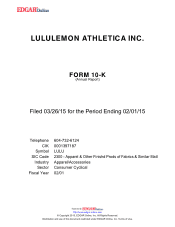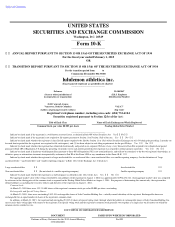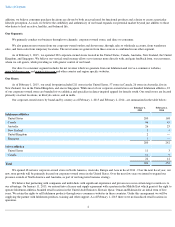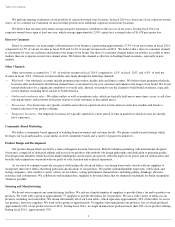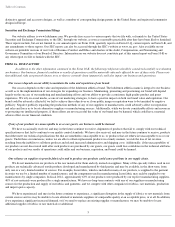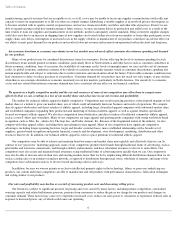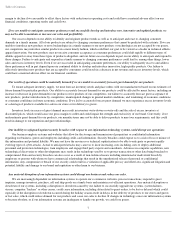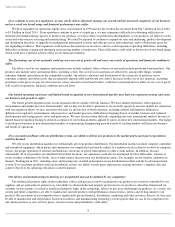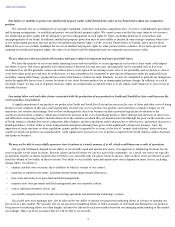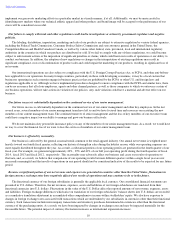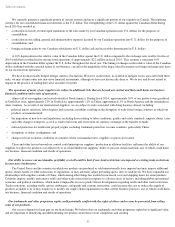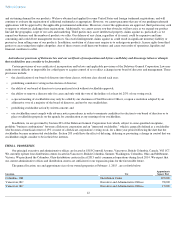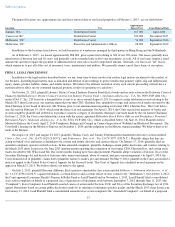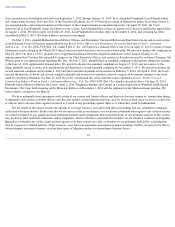Lululemon 2014 Annual Report Download - page 10
Download and view the complete annual report
Please find page 10 of the 2014 Lululemon annual report below. You can navigate through the pages in the report by either clicking on the pages listed below, or by using the keyword search tool below to find specific information within the annual report.
Table of Contents
manufacturing capacity on terms that are acceptable to us, or at all, or we may be unable to locate any supplier or manufacturer with sufficient
capacity to meet our requirements or to fill our orders in a timely manner. Identifying a suitable supplier is an involved process that requires us
to become satisfied with its quality control, responsiveness and service, financial stability and labor and other ethical practices. Even if we are
able to expand existing or find new manufacturing or fabric sources, we may encounter delays in production and added costs as a result of the
time it takes to train our suppliers and manufacturers in our methods, products and quality control standards. Delays related to supplier changes
could also arise due to an increase in shipping times if new suppliers are located farther away from our markets or from other participants in our
supply chain. Any delays, interruption or increased costs in the supply of fabric or manufacture of our products could have an adverse effect on
our ability to meet guest demand for our products and result in lower net revenue and income from operations both in the short and long term.
An economic downturn or economic uncertainty in our key markets may adversely affect consumer discretionary spending and demand
for our products.
Many of our products may be considered discretionary items for consumers. Factors affecting the level of consumer spending for such
discretionary items include general economic conditions, particularly those in North America and other factors such as consumer confidence in
future economic conditions, fears of recession, the availability of consumer credit, levels of unemployment, tax rates and the cost of consumer
credit. As global economic conditions continue to be volatile or economic uncertainty remains, trends in consumer discretionary spending also
remain unpredictable and subject to reductions due to credit constraints and uncertainties about the future. Unfavorable economic conditions may
lead consumers to delay or reduce purchase of our products. Consumer demand for our products may not reach our sales targets, or may decline,
when there is an economic downturn or economic uncertainty in our key markets, particularly in North America. Our sensitivity to economic
cycles and any related fluctuation in consumer demand may have a material adverse effect on our financial condition.
We operate in a highly competitive market and the size and resources of some of our competitors may allow them to compete more
effectively than we can, resulting in a loss of our market share and a decrease in our net revenue and profitability.
The market for technical athletic apparel is highly competitive. Competition may result in pricing pressures, reduced profit margins or lost
market share or a failure to grow our market share, any of which could substantially harm our business and results of operations. We compete
directly against wholesalers and direct retailers of athletic apparel, including large, diversified apparel companies with substantial market share
and established companies expanding their production and marketing of technical athletic apparel, as well as against retailers specifically
focused on women's athletic apparel. We also face competition from wholesalers and direct retailers of traditional commodity athletic apparel,
such as cotton T-shirts and sweatshirts. Many of our competitors are large apparel and sporting goods companies with strong worldwide brand
recognition, such as Nike, Inc., adidas AG, The Gap, Inc. and Under Armour, Inc. Because of the fragmented nature of the industry, we also
compete with other apparel sellers, including those specializing in yoga apparel. Many of our competitors have significant competitive
advantages, including longer operating histories, larger and broader customer bases, more established relationships with a broader set of
suppliers, greater brand recognition and greater financial, research and development, store development, marketing, distribution and other
resources than we do. In addition, our technical athletic apparel is sold at a price premium to traditional athletic apparel.
Our competitors may be able to achieve and maintain brand awareness and market share more quickly and effectively than we can. In
contrast to our "grassroots" marketing approach, many of our competitors promote their brands through traditional forms of advertising, such as
print media and television commercials, and through celebrity endorsements, and have substantial resources to devote to such efforts. Our
competitors may also create and maintain brand awareness using traditional forms of advertising more quickly than we can. Our competitors
may also be able to increase sales in their new and existing markets faster than we do by emphasizing different distribution channels than we do,
such as catalog sales or an extensive franchise network, as opposed to distribution through retail stores, wholesale or internet, and many of our
competitors have substantial resources to devote toward increasing sales in such ways.
In addition, because we own no patents or exclusive intellectual property rights in the technology, fabrics or processes underlying our
products, our current and future competitors are able to manufacture and sell products with performance characteristics, fabrication techniques
and styling similar to our products.
Our sales and profitability may decline as a result of increasing product costs and decreasing selling prices.
Our business is subject to significant pressure on pricing and costs caused by many factors, including intense competition, constrained
sourcing capacity and related inflationary pressure, pressure from consumers to reduce the prices we charge for our products and changes in
consumer demand. These factors may cause us to experience increased costs, reduce our sales prices to consumers or experience reduced sales in
response to increased prices, any of which could cause our operating
6

